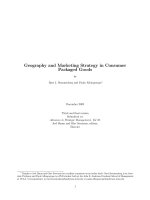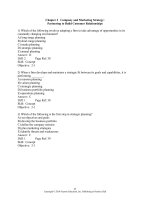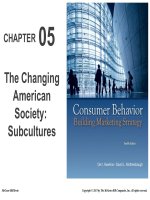Consumer behavior and marketing strategy 12e hawkins motherbaugh chapter 09
Bạn đang xem bản rút gọn của tài liệu. Xem và tải ngay bản đầy đủ của tài liệu tại đây (2.57 MB, 32 trang )
CHAPTER
09
Learning,
Memory, and
Product
Positioning
McGraw-Hill/Irwin
Copyright © 2013 by The McGraw-Hill Companies, Inc. All rights reserved.
9-2
Learning Objectives
Describe the nature of learning and memory
Explain the types of memory and memory's role in
learning
Distinguish the different processes underlying highand low-involvement learning
Summarize the factors affecting information retrieval
from memory
Understand the application of learning to brand
positioning, equity, and leverage
9-3
Consumer Behavior In The News…
Can a brand make consumers more creative? To find
out:
Three groups were flashed a different computer
brand logo and then asked to write down all the
uses of a brick they could think of.
Which computer logo generated the most creativity
(more uses for a brick)?
No Brand (control group)
IBM
Apple
Source: B. S. Bulik, “This Brand Makes You More Creative,” Advertising Age, March 24, 2008, p. 4
9-4
Consumer Behavior In The News…
If you said Apple you are correct. The number of uses
for a brick were as follows:
Apple: 7.5
No Brand (control group): 6
IBM: 5
Why? Brand image (e.g., creativity) may prime a trait
that taps our self image and affects our behaviors.
Note: Flash was 30 milliseconds or subliminal and thus participants didn’t know
or see the brand logo, preventing conscious biasing of effort, etc.
Source: B. S. Bulik, “This Brand Makes You More Creative,” Advertising Age, March 24, 2008, p. 4
9-5
The Nature of Learning and Memory
9-6
Memory’s Role in Learning
Memory consists of two interrelated components:
components
1. Short-term Memory (STM) a.k.a. working memory
•
is that portion of total memory that is currently activated
or in use.
2. Long-term Memory (LTM)
•
is that portion of total memory devoted to permanent
information storage.
•
Semantic memory is the basic knowledge and
feelings an individual has about a concept.
•
Episodic memory is the memory of a sequence of
events in which a person participated.
9-7
Memory’s Role in Learning
Short-Term Memory
STM is Short Lived
•
Consumers must constantly refresh information through
maintenance rehearsal or it will be lost.
STM has Limited Capacity
•
Consumers can only hold so much information in
current memory.
Elaborative Activities Occur in STM
•
Elaborative activities serve to redefine or add new
elements to memory and can involve both concepts
and imagery.
imagery
9-8
Applications in Consumer Behavior
Duracell’s unique ad
placement is a perfect
example of imagery
designed to enhance
elaborative activities
regarding the brand.
Courtesy Ogilvy & Mather Kuala Lumpur
9-9
Memory’s Role in Learning
Long-Term Memory
Schemas (a.k.a. schematic memory)
Scripts
Retrieval from LTM
9-10
Memory’s Role in Learning
A Partial Schematic Memory for Mountain Dew
9-11
Learning Under High- and Low-Involvement
9-12
Learning Under High- and Low-Involvement
Classical Conditioning
Classical conditioning is the process of using an established
relationship between one stimulus (music) and response (pleasant
feelings) to bring about the learning of the same response
(pleasant feelings) to a different stimulus (the brand).
9-13
Learning Under High- and Low-Involvement
Operant Conditioning
Operant conditioning (or instrumental learning) involves
rewarding desirable behaviors such as brand purchases with a
positive outcome that serves to reinforce the behavior.
9-14
Learning Under High- and Low-Involvement
Shaping Can Be Used in Operant Conditioning
9-15
Learning Under High- and Low-Involvement
Cognitive Learning
1. Iconic Rote Learning
2. Vicarious Learning/Modeling
3. Analytical Reasoning
9-16
Learning Under High- and Low-Involvement
9-17
Learning, Memory, and Retrieval
Marketers want consumers to learn and remember positive
features, feelings, and behaviors associated with their
brands.
9-18
Learning, Memory, and Retrieval
Forgetting over Time: Magazine Advertisement
Source: LAP Report #5260.1 (New York: Weeks McGraw-Hill, undated). Reprinted with
permission from McGraw-Hill Companies, Inc.
9-19
Learning, Memory, and Retrieval
Strength of Learning
Memory Interference
Response Environment
9-20
Learning, Memory, and Retrieval
Strength of Learning
Strength of learning is enhanced by six factors:
1. Importance
2. Message Involvement
3. Mood
4. Reinforcement
5. Repetition
6. Dual Coding
9-21
Learning, Memory, and Retrieval
Impact of Repetition on Brand Awareness for High- and Low-Awareness Brands
Source: A Study of the effectiveness of Advertising Frequency in Magazines, 1993 Time, Inc. Reprinted by permission.
9-22
Learning, Memory, and Retrieval
Repetition Timing and Advertising Recall
Source: Reprinted from H. J. Zielski, “The Remembering and Forgetting of Advertising,” Journal of Marketing, January 1959, p. 240, with permission from The American Marketing Association. The actual
data and a refined analysis were presented in J. L. Simon, “What Do Zielski’s Data Really Show about Pulsing?” Journal of Marketing Research, August 1979, pp. 415-20.
9-23
Learning, Memory, and Retrieval
Memory interference occurs when consumers have
difficulty retrieving a specific piece of information because
other related information in memory gets in the way.
A common form of interference in
marketing is due to competitive
advertising.
Competitive advertising makes it
harder for consumers to recall any
given advertisement and its
contents.
9-24
Learning, Memory, and Retrieval
9-25









